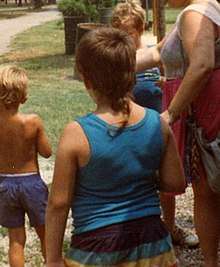Rattail (haircut)

A rattail is a hair style that is characterized by a long "tail"-like element of hair growing downward from the back of the head. The rattail usually hangs naturally; however, it can be braided, treated as a dread, permed, straightened, or poofed, curled with an iron. In some instances, an individual might choose to grow several tails as opposed to a single very long tail.[1]
The rattail saw a brief period of mainstream popularity during the late 1980s and early 1990s and has rapidly fallen out of vogue. However, it has recently[2] seen renewed popularity.
Cultural prevalence
Some punks and rivetheads have been known to sport them also, although in a much more punky style, totally shaven head, except for a tuft of hair at the back, usually dyed in various luminous colours. It is a very popular hairstyle in Broome (Australia) and New Zealand, especially among boys, and is sometimes combined with shaven sides, a soft faux-hawk.
Former junior welterweight boxing champion Kostya Tszyu sported a rather famous rattail throughout his career.[3]
In Disney's 2002 animated feature Treasure Planet, Jim Hawkins sports a rattail throughout the movie until the end. [4] In the 2016 film American Honey, Shia LaBeouf's rattail garnered critical praise.[5] In the 2017 film Wonder, August "Auggie" Pullman has a rattail during the beginning of the movie, until he cuts it after he gets made fun of it.[6]
See also
References
| Wikimedia Commons has media related to Rattail haircut. |
- ↑ "Rat Tail Hairstyle". Retrieved February 15, 2010.
- ↑ "Is the rat-tail, the worst men's hairstyle ever, making a comeback?".
- ↑ "Shane Mosley & Kostya Tszyu: Boxing's Smiling Assassins". Retrieved February 15, 2010.
- ↑ "Oh, Rihanna! Singer Debuts New Rat Tail Mullet".
- ↑ "In Praise of Shia LaBeouf's American Honey Rattail". 30 September 2016.
- ↑ Merry, Stephanie. "Review: 'Wonder' is the cry-fest you expect, but it's also complex, funny and probing". The Spokesman-Review. Washington Post. Retrieved 24 November 2017.